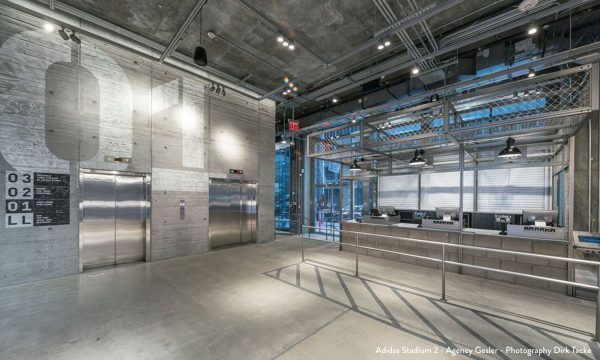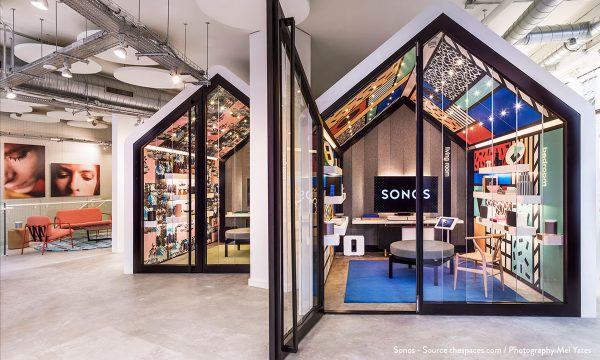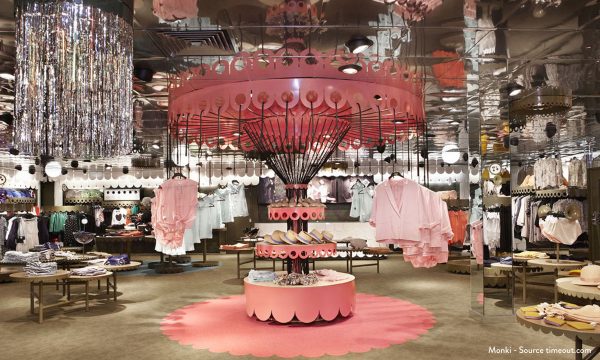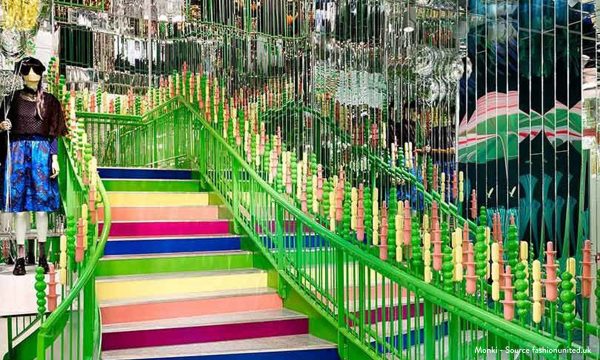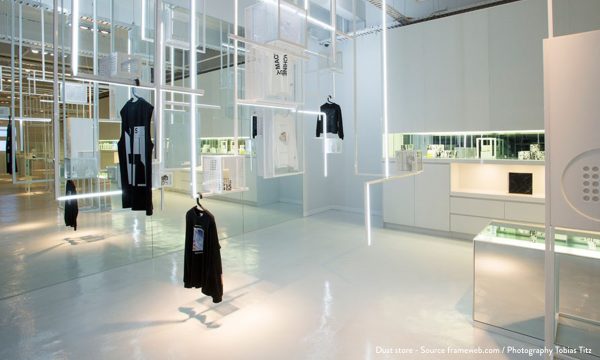Immersive is the word of the moment. From immersive experiences, to immersive retail, to immersive e-commerce – its omnipresence in the retail language suggests that it’s intrinsic to any successful retail strategy. It’s an all-encompassing term with a somewhat hazy definition, covering everything from remarkable experiences and innovative spaces to digitalization in retail and virtual reality. To understand what it really means and how immersive strategies work, we need to dig a little deeper into the word’s semantics and taxonomy.

First emerging in 2008 with the advent of Second Life, the term ‘immersive’ was used to describe a new type of virtual online experience. By 2013, the word had become more deeply entrenched in popular culture and the media, reaching its peak today with augmented reality.
Etymologically, to be ‘immersed’ means to be submerged in a liquid. It’s this feeling of finding oneself in a jarring state of ‘shift’ which really interests experiential designers. In other words, the aim is to produce a sensory rift in a familiar or anticipated environment. Sound, sight, touch, 3D imagery and virtual reality all offer a wealth of stimuli for creating an immersive experience.
New forms of immersivity are now challenging the multi-sensory approach. Immersive theatre – which is part of the live entertainment trend – is on the rise; targeting not the artificial, but the ‘real’. It relies not only on the sensory shift, but aims to focus the mind on a specific moment in time.
The omnipresence of digital devices in today’s world means our attention is continuously divided. The average Facebook user logs in 14 times a day, spending a total of around one hour and 45 minutes browsing the site. And smartphone users check their phone every 10 minutes on average, each time for less than 30 seconds. Our permanently distracted state of concentration – trying to focus on multiple sources of information at once – is not an oxymoron but a reality.
The retail industry is not immune to this phenomenon either. Capturing and retaining someone’s attention, making them forget that they might be missing something more interesting on social media, gives new meaning to the term immersivity: the experience of being fully present.
The emergence of concept stores is a product of this shift, combining the shopper’s sensory engagement behaviour with digital technology to create a cohesive and standardized buyer’s journey and an uninterrupted, immersive experience.
From a more real to a more virtual approach, from comprehensive brand narratives to complete dissolution, retail strategies to keep the shopper (fully) immersed are continuously evolving.
Elsewhere is here
Immersive retail feeds on the desire for ubiquity by transporting the customer somewhere they didn’t expect to be, in surroundings that are typically found elsewhere.
The Adidas Stadium flagship store is a prime example. A 4,000 m² US high school stadium transplanted into the centre of New York; it features a tunnel entrance, changing rooms, training facilities complete with spectator stands, product test tracks and even fitness consultations. With a mix of real-life stadium features, a NYC sports décor theme and a raw, unfinished aesthetic, Adidas’ narrative revolves around the world of the stadium. Every touch point echoes the theme, some more realistic and literal, and others more conceptual to showcase the innovation at work.
At Sonos’ flagship store in the SoHo area of New York, the company’s shrine to smart sound beckons visitors to explore an immersive experience that combines its base material – sound – with digital expertise. Six soundproofed huts, modelled on different living spaces, recreate the acoustics in the customer’s home, enabling them to make an informed choice based on real-life conditions. Once comfortably seated in their preferred ‘home’, they can select either a film or music on a dedicated tablet. Online music catalogues are also available. The chosen sound bite can be compared on the brand’s three different sound systems. Ambient lighting is synchronized with the music, creating a visual display that intensifies the immersive experience. Meanwhile, the store’s mobile sales team handle customer requests to minimize dead time and discourage people from leaving. A vintage-style lounge entices visitors passing through, providing a space where they can relax and listen to records or cassette tapes.
The power of storytelling
Fiction is a powerful immersive strategy. Games and fantasy brands are leading the way, with Lego’s giant Lego Land concept stores at the forefront of the movement. The brand uses colour and change of scale to create an immersive experience for visitors, who find themselves reduced to the size of a figurine, or vice versa. Digital technology also plays a part, with the ‘digital box’ enabling customers to present Lego kits to the screen and watch their construction in 3D, thanks to augmented reality.
Part of the H&M group, fashion brand Monki combines Scandinavian cool with Asian street style to create an immersive fantasy experience in its stores. Based on the funfair retail concept, the result is a lively bazaar where a maze of curiosities keeps customers constantly entertained – another key immersive strategy.
But fiction is not just something used by young, fun and offbeat brands. For the opening of its New York concept store, long-established brand Dyson created a futuristic space that tells the story of the company. Visitors are greeted by a giant, Dyson Digital Motor, whilst interactive Space Age-style demonstrations complement each product display, breaking down the technology intrinsic to the company’s products.
Immersion through dissolution
The Dust concept store in Melbourne hails the arrival of a new type of immersivity, blurring the lines between clothing production and distribution. An extraordinary gallery-workshop hybrid, the store features a matrix-style metal grid that serves as a backdrop to the space and is devoid of any overt visual merchandising. Customers are encouraged to explore the physical garments, before selecting their desired customization via a tablet and waiting for their item to be created on-site. Immersivity asserts itself through the break with retail store tradition, the visual, auditory and olfactory stimuli, and the digital technology, which combines the flexibility of online shopping with the instant gratification of in-store purchases.
Art and augmented reality
Could art be the new gold standard in immersivity? Some artistic movements have the inherent ability to take the real and elevate it to another level. Surrealism, abstraction and kinetic art have always experimented with shifting reality. Now dance is stepping in with a new type of immersive experience.
A prime example is the short film created jointly by Barneys and the Martha Graham Dance Company. Shot on a 360° virtual reality camera, it places the viewer at the centre of the performance, with the dancers circling around them. The interaction between performers and public creates a ballet that is different every time – unique to each individual viewer. The dancers are clad in the creations of cutting-edge fashion designers (Prabal Gurung, The Row, Rick Owens and Loewe) that correspond to the common character archetypes that they portray: Power, Ethereal, Possessed and The Cleaner.
There is no longer a disconnect between the material and the digital in immersivity. Each new immersive retail concept pushes the boundaries ever further in its quest for emotive reaction. Every store wants to change the world in some way. If this new approach is successful, using new technologies to personalize experiences may transcend conventional retail strategies, paving the way for a new, immersive sales culture.

